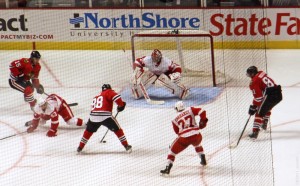When the National Hockey League implemented the shootout back in 2005, it seemed as if there was unanimous support for an exhilarating and refreshing way to end ties. That sentiment has certainly changed.

The latest subject of controversy revolves around Ottawa Senator and Latvian-born Kaspars Daugavins, who stole the show in his team’s shootout loss Tuesday to the Boston Bruins. As the puck was placed at centre ice, Daugavins put his blade on top of the puck and skated it towards the goal ringette style. The shot didn’t cross the line, but that didn’t stop the attempt from creating opinions and jumpstarting arguments. Ranging from Boston Bruin David Krejci’s distaste for the move and Senators coach Paul MacLean’s approval, everyone had something to say about the bottom 6 forward.
First off, it has to be disclosed that the move Daugavins made was not outside of the confines of the shootout rules. There is no argument that this shootout move was completely legal. There was constant forward momentum and the puck remained along the ice. It can’t even be considered showboating, which is what it was immediately classified as. Simply put, Kaspars Daugavins did what he felt would get the puck into the back of the net, which is the way that one team earns the extra point at stake. That being said, no elements of hockey were represented in his shot. Aside from an actual case of showboating by phil Bourquein a game decades ago, nobody has ever done what Daugavins attempted in a real game. It came off as a gimmick that should only be seen in skills competitions. However if that is the feeling on this goal, it raises an even bigger topic of discussion. Kaspars Daugavins’ move was fairly unconventional, pre-planned, and was best suited for a less serious occasion. It was representative of the shootout itself, and the problems that it presents in the purity and reputation of hockey.
Aside from the penalty shot, which is seen very rarely in a season, the shootout is not an accurate representation of the sport. Even from the earliest stages of organized play, kids play one-on-one or two-on-one scenarios out on the ice. Why? Because calculated breakaways are just too remote even to play out. Rather, the components of the game such as defending, passing, and vision are the skills that are seen and are exhibited at every level of the sport. For 60 (and sometimes 65) minutes, that is what every hockey fan sees. An inability to replicate this in what seems to decide the outcome of at least a game every night doesn’t reward the potentially better team but rather two or three players.
Also, the National Hockey League has made great progress in the past decade to establish hockey as a legitimate sport option among the standard households in the United States. ESPN and other large American-based sports networks (save for NBC) have spent years looking down upon the sport, opting to show insignificant highlights at the end of their shows. Fights, objects being thrown on the ice , and the rare idiotic fan make the morning highlights. There’s nothing wrong with these things, as they’re a part of hockey and give the sport a unique culture. However what has been neglected is what makes the game so appealing to those who religiously follow the sport. A heart and soul shift with three blocked shots from Callahan, an incredible down-low cycle followed up with a brilliant pass by Crosby, or a gigantic stick save from Kari Lehtonen. They make hockey special and addicting to watch, and what will ultimately pull people towards the game. Not the shootout, which is next in line to be the general and ignorant interpretation of “hockey”.
Is the shootout ever exciting? Of course it is. Even the most vocal and adamant critics of the tiebreaker can’t help but be impressed by the attempts of Patrick

Kane, Sam Gagner, or Pavel Datsyuk. It showcases the immense individual talents that some of the game’s finest posses. However, never can three skaters solely determine the outcome of a 60 minute hockey game. Teams obviously rely on their best players to carry play, but ultimately hockey is won and lost by all nineteen players on the squad. Similar to how a basketball team cannot win a game on a three point contest, as that would be deemed unrealistic, hockey teams should not be able to let the individual performances of a small portion of the team determine who gains two points.
If you’re going to hate Kaspars Daugavins and his shootout move, you have to despise the shootout itself. Daugavins’ attempt was planned prior to his shot (obviously), has been and will be considered actual hockey by those who do not follow the sport, and puts the individual over the team. While it was much flashier than most, Daugavins’ move is no different from any other shootout. However, it will take less backhand shots from Lauri Korpikoski and more extravagant attempts like the one from Kaspars Daugavins to show what is wrong with the shootout and eventually bring forth change.